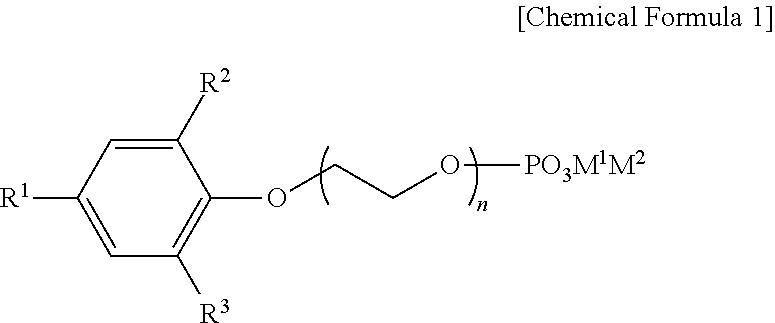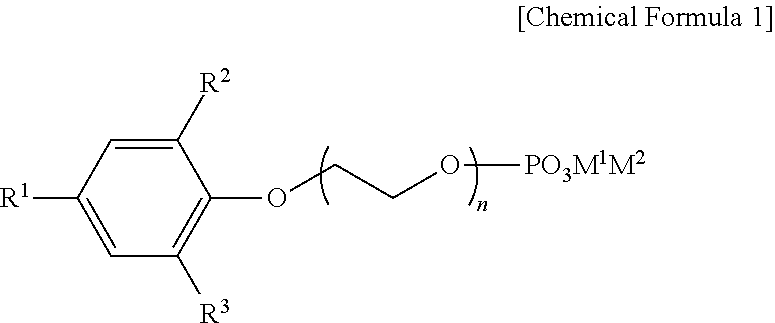Preparation method of organic zinc catalyst and poly(alkylene carbonate) resin
a technology of organic zinc and poly(alkylene carbonate) resin, which is applied in the direction of catalyst activation/preparation, organic compound/hydride/coordination complex catalyst, chemical process catalyst, etc., can solve the problem of difficult control of zinc dicarboxylate-based catalyst, carbon dioxide concentration, and activity deterioration, etc. problem, to achieve the effect of excellent activity and uniform particle siz
- Summary
- Abstract
- Description
- Claims
- Application Information
AI Technical Summary
Benefits of technology
Problems solved by technology
Method used
Image
Examples
example 1
on of Organic Zinc Catalyst in Presence of Dispersant (Molar Ratio of ZnO and Glutaric Acid=1:1.2)
[0086]In a 250 mL round bottom flask, 7.93 g (0.06 mol) of glutaric acid and 0.1 mL of acetic acid were added to and dispersed in 100 mL of toluene under reflux, followed by heating at 55° C. for 30 minutes.
[0087]Separately, 4.1 g (0.05 mol) of ZnO was added to and stirred with 50 mL of toluene to which 0.02 g of nonylphenol ethoxylated phosphate ester was added, thereby preparing a Zn dispersion.
[0088]The ZnO dispersion was divided into 4 portions based on volume, and a reaction was performed by primarily adding a ¼ portion of the ZnO dispersion to a glutaric acid solution. After 1 hour, the reaction was performed by adding another ¼ portion of the ZnO dispersion, and after 1 hour therefrom, the reaction was performed by adding another ¼ portion of the ZnO dispersion. After another hour, the reaction was performed by adding the remaining ¼ portion of the ZnO dispersion. The mixed solut...
example 2
on of Organic Zinc Catalyst in Presence of Dispersant (Molar Ratio of ZnO and Glutaric Acid=1:1.5)
[0090]In a 250 mL round bottom flask, 9.91 g (0.075 mol) of glutaric acid and 0.1 mL of acetic acid were added to and dispersed in 100 mL of toluene under reflux, followed by heating at 55° C. for 30 minutes.
[0091]Separately, 4.1 g (0.05 mol) of ZnO was added to and stirred with 50 mL of toluene to which 0.02 g of nonylphenol ethoxylated phosphate ester was added, thereby preparing a Zn dispersion.
[0092]The ZnO dispersion was divided into 4 portions based on volume, and a reaction was performed by adding a ¼ portion of the ZnO dispersion to a glutaric acid solution. After 1 hour, the reaction was performed by adding another ¼ portion of the ZnO dispersion, and after 1 hour therefrom, the reaction was performed by adding another ¼ portion of the ZnO dispersion. After an additional hour, the reaction was performed by adding the remaining ¼ portion of the ZnO dispersion. The mixed solution...
example 3
on of Organic Zinc Catalyst in Presence of Dispersant (Molar Ratio of ZnO and Glutaric Acid=1:1)
[0094]In a 250 mL round bottom flask, 6.61 g (0.05 mol) of glutaric acid and 0.1 mL of acetic acid were added to and dispersed in 100 mL of toluene under reflux, followed by heating at 55° C. for 30 minutes.
[0095]Separately, 4.1 g (0.05 mol) of ZnO was added to and stirred with 50 mL of toluene to which 0.02 g of nonylphenol ethoxylated phosphate ester was added, thereby preparing a Zn dispersion.
[0096]The ZnO dispersion was divided into 4 portions based on volume, and a reaction was performed by adding a ¼ portion of the ZnO dispersion to a glutaric acid solution. After 1 hour, the reaction was performed by adding another ¼ portion of the ZnO dispersion, and after 1 hour therefrom, the reaction was performed by adding another ¼ portion of the ZnO dispersion. After an additional hour, the reaction was performed by adding the remaining ¼ portion of the ZnO dispersion. The mixed solution wa...
PUM
| Property | Measurement | Unit |
|---|---|---|
| particle size | aaaaa | aaaaa |
| particle size distribution | aaaaa | aaaaa |
| particle size distribution | aaaaa | aaaaa |
Abstract
Description
Claims
Application Information
 Login to View More
Login to View More - R&D
- Intellectual Property
- Life Sciences
- Materials
- Tech Scout
- Unparalleled Data Quality
- Higher Quality Content
- 60% Fewer Hallucinations
Browse by: Latest US Patents, China's latest patents, Technical Efficacy Thesaurus, Application Domain, Technology Topic, Popular Technical Reports.
© 2025 PatSnap. All rights reserved.Legal|Privacy policy|Modern Slavery Act Transparency Statement|Sitemap|About US| Contact US: help@patsnap.com


